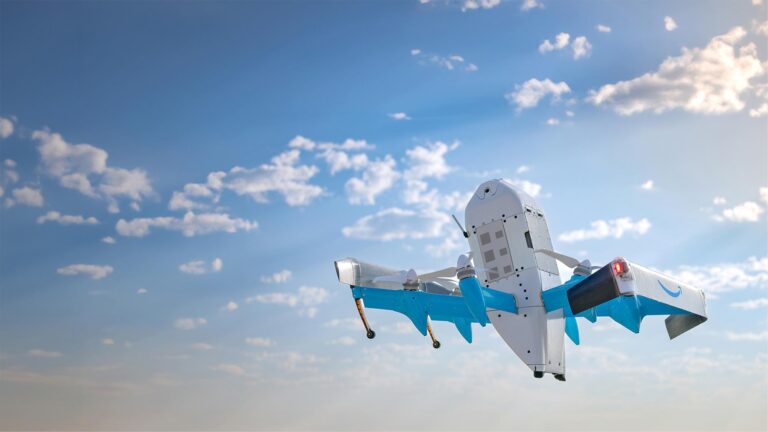Amazon has officially launched its much-anticipated drone delivery service in Arizona, marking a significant milestone in the evolution of e-commerce logistics. This innovative program aims to provide customers with faster, more efficient deliveries by utilizing autonomous drones to transport packages directly to their doorsteps. The rollout in Arizona represents Amazon’s first large-scale implementation of drone technology, reflecting the company’s commitment to pioneering cutting-edge solutions in last-mile delivery. As the service takes flight, industry experts and consumers alike are watching closely to see how this new mode of delivery will reshape the future of online shopping.
Amazon launches inaugural drone delivery service in Arizona
Amazon’s latest step in revolutionizing delivery service has officially commenced as drones begin making their first commercial trips in select Arizona neighborhoods. This bold move promises to drastically cut delivery times and reduce the environmental impact associated with traditional delivery vehicles. Equipped with advanced navigation technology and safety protocols, the fleet of drones will efficiently transport packages weighing up to 5 pounds, bringing essentials and small items directly to customers’ doorsteps within minutes.
The deployment includes a network of launch stations strategically placed to optimize flight paths and coverage. Key features of the program include:
- Precision delivery: Utilizing GPS and computer vision for secure package drop-offs
- Eco-friendly flights: Battery-powered drones reducing carbon emissions
- Real-time tracking: Customers can monitor their package from dispatch to arrival through the Amazon app
| Delivery Metrics | Drone Service | Traditional Delivery |
|---|---|---|
| Average Delivery Time | 15 minutes | 1-2 days |
| Maximum Package Weight | 5 lbs | Unlimited |
| Carbon Emission per Delivery | Zero (electric) | Approx. 1.5 lbs COâ‚‚ |
How Amazon’s drone technology is reshaping last-mile logistics
Amazon is revolutionizing the way packages reach customers by deploying innovative drone technology that cuts delivery times and reduces reliance on traditional vehicle fleets. These drones, equipped with advanced navigation systems and safety features, are capable of navigating diverse terrains and delivering goods directly to customers’ doorsteps within minutes. This breakthrough not only accelerates the delivery process but also promises significant environmental benefits by lowering carbon emissions associated with last-mile logistics.
Key features of Amazon’s drone delivery system include:
- Autonomous flight with obstacle avoidance for increased safety
- Capability to carry packages weighing up to 5 pounds
- Integration with Amazon’s existing logistics network for seamless order processing
- Real-time tracking and status updates for customers
| Aspect | Benefit |
|---|---|
| Delivery Speed | Under 30 minutes for eligible orders |
| Environmental Impact | Reduced carbon footprint by minimizing truck routes |
| Operational Range | Up to 15 miles from distribution center |
| Customer Experience | Contactless, convenient doorstep delivery |
Safety protocols and regulatory challenges in drone deliveries
Amazon’s pioneering drone delivery initiative in Arizona is navigating a complex landscape of safety measures and regulatory oversight designed to protect both the public and the environment. Each drone is equipped with advanced sensors and geofencing technology to prevent collisions and avoid restricted airspaces. Regular maintenance checks and real-time flight monitoring ensure operational safety, while strict guidelines govern the maximum weight and flight altitude of parcels. These protocols reflect Amazon’s commitment to integrating cutting-edge technology with responsible aerial logistics.
However, the regulatory environment presents significant challenges. Federal and state aviation authorities require Amazon to obtain multiple certifications, comply with privacy regulations, and undergo rigorous flight testing before expanding routes. The table below summarizes key regulatory milestones and current compliance requirements for drone delivery operations:
| Regulatory Requirement | Status | Impact on Operations |
|---|---|---|
| FAA Part 107 Certification | Obtained | Allows commercial drone flights |
| Remote Identification Mandate | In Progress | Enhances tracking and accountability |
| Privacy Compliance | Ongoing | Protects consumer data and imagery |
| Local Flight Permissions | Partial | Limits expansion to select zones |
- Technological safeguards minimize risk in residential areas.
- Regulatory approvals continue to shape the rollout pace.
- Community engagement helps address privacy and safety concerns.
Recommendations for expanding drone delivery services nationwide
To scale Amazon’s drone delivery system beyond its Arizona launch, strategic partnerships with local governments and regulatory bodies will be essential. Streamlining airspace regulations and standardizing drone certification processes can accelerate nationwide implementation while maintaining safety standards. Moreover, investment in advanced traffic management systems that integrate with existing aviation infrastructure will help mitigate risks and optimize flight paths for drones delivering packages across urban and rural areas alike.
Key steps to facilitate expansion include:
- Developing interoperable communication networks for real-time drone monitoring
- Accelerating federal approvals with pilot programs in diverse geographic regions
- Enhancing drone battery technology for extended range and payload capacity
- Engaging communities through educational initiatives to build trust and acceptance
| Factor | Impact | Timeframe |
|---|---|---|
| Regulatory Alignment | High – Enables efficient operations | 12-18 Months |
| Technology Upgrades | Medium – Improves reach & payload | 6-12 Months |
| Community Engagement | Medium – Builds public trust | Ongoing |
Key Takeaways
As Amazon’s drone delivery service officially launches in Arizona, it marks a significant step forward in the company’s ongoing efforts to revolutionize last-mile logistics. While challenges remain, including regulatory hurdles and operational scalability, this initiative underscores Amazon’s commitment to innovation and customer convenience. Industry watchers will be closely monitoring the rollout to see how drone deliveries reshape the future of e-commerce fulfillment. For now, Arizona residents can look forward to a glimpse of the skies buzzing with the promise of faster, more efficient deliveries.







